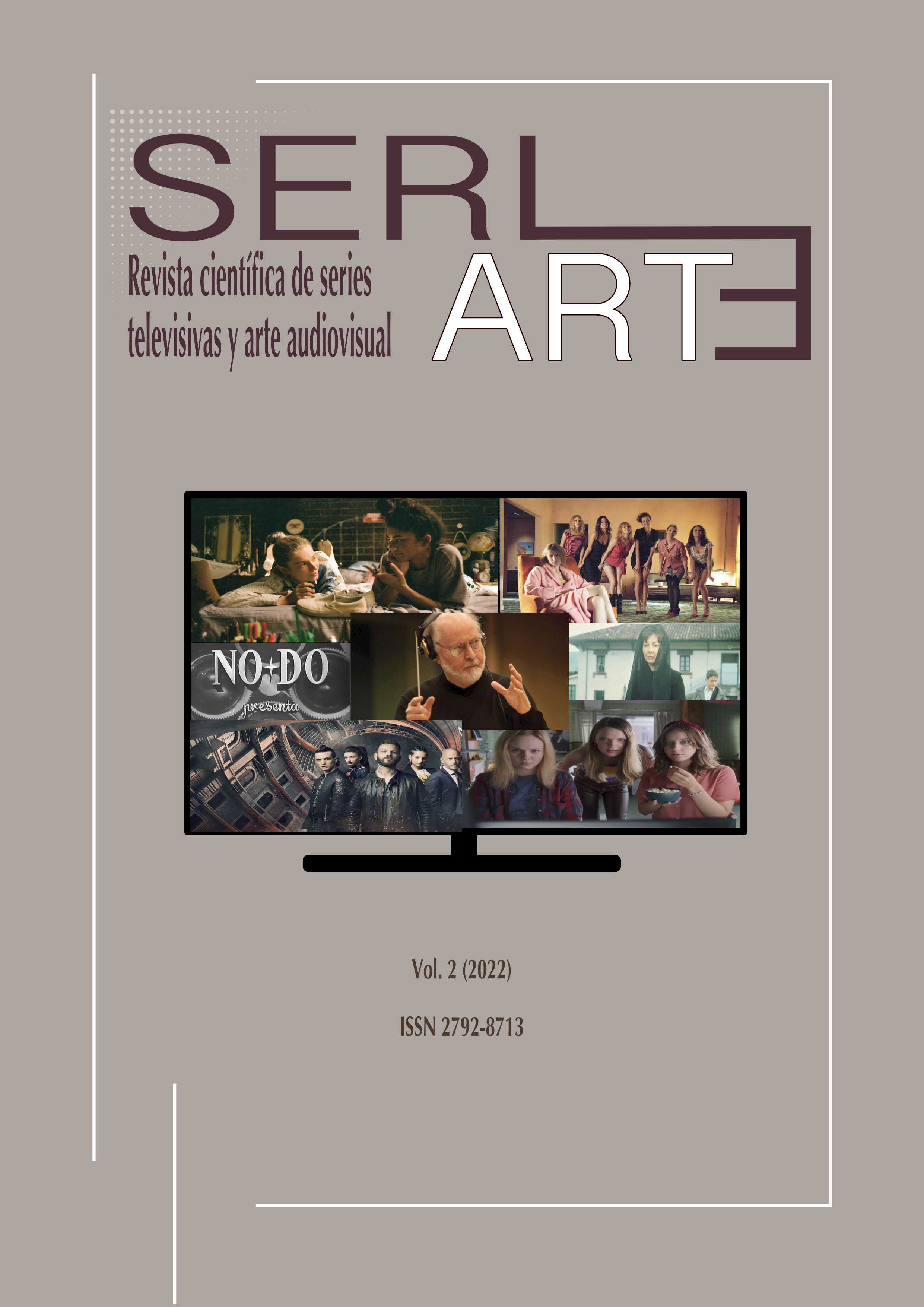Personajes “euphoricos”: lo Crip y lo Queer a través de la intertextualidad audiovisual en Euphoria
Contenido principal del artículo
Resumen
Géneros, sexualidades y cuerpos no normativos, aparecen representadas en series de televisión. A este respecto, las teorías crip y queer exponen, de forma crítica, la capacidad corporal obligatoria frente a la discapacidad, y la obligatoriedad heteronormativa frente a multitudes de géneros y sexualidades.
Este artículo pretende emplear la perspectiva crip/queer para analizar a tres de los personajes principales en la primera temporada de la serie Euphoria (HBO, 2019), a través de las referencias intertextuales audiovisuales. Y reflexionar si se sigue privilegiando la heteronormatividad patriarcal sin discapacidad o, por el contrario, hay una modificación del discurso para cuestionar la perspectiva dominante. Esta transformación discursiva se produce con la identificación con personajes queer/crip, y mediante un juego intertextual performativo que reinterpreta esas referencias. Ambos aspectos producen un desplazamiento, en unos casos, y una disolución, en otros, del dispositivo activo/pasivo -o sujeto/objeto- para expresar el deseo y las relaciones entre personajes.
Descargas
Datos de publicación
Perfil evaluadores/as N/D
Declaraciones de autoría
Indexado en
- Sociedad académica
- Seriarte. Revista científica de series televisivas y arte audiovisual
- Editorial
- Ucopress. Cordoba University Press
Detalles del artículo
Citas
AUSLANDER, Philip (2016). Performing and Glam Rock, Gender and Theatrical in Popular Music. Chicago: The University of Michigan Press.
BARRHES, Roland (2014). S/Z. Madrid: Siglo XXI.
BELL, Kristen y McNAUGHTON, Darlene (2007). “Feminism and the Invisible Fat Man”. Body and Society, 13 (1), pp. 107-131. https://journals.sagepub.com/doi/10.1177/1357034X07074780
BENSHOFF, Harry M. (1997). Monsters in the Closet: Homosexuality and the Horror Film. Manchester: Manchester University Press.
BORDWELL, David, THOMPSON, Kristen y SMITH, Jeff (2016). Film Art: An Intrduction. New York: McGraw Hill.
BRUUN VAAGE, Margrethe (2021). “Five theses on the difficulty of ending Quality TV series”. En Ted Nannicelli, Héctor J. Pérez (Eds.) Cognition, Emotion, and Aesthetics in Contemporary Serial Television, London: Routladge, pp. 160-175.
BUTLER, Judith (1990). Gender Trouble: Feminism and the Subversion of Identity. London: Routledge.
BUTLER, Judith (1993). “Critically queer”. GLQ: A Journal of Lesbian and Gay Studies, 1(1), pp. 17-32. https://doi.org/10.1215/10642684-1-1-17
BUTLER, Judith (2002). Cuerpos que importan. Buenos Aires: Paidos.
COMBI, Cloe (2015). Generation Z: Their voices, their lifes. London: Hutchinson.
DOMARCHI, Jean, DONIOL-VALCROZE, Jacques, GODARD, Jean-Luc., KAST, Pierre, RIVETTE, Jacques y ROHMER, Eric (1959). “Hiroshima, notre amour”. Cahiers du cinéma (97), pp. 1-18.
DE LAURENTIS, Teresa (1987). Technologies of Gender. Essays on Theory, Film and Fiction. Bloomnigton: Indiana University Press.
FOUCAULT, Michael (2007). El nacimiento de la biopolítica. Buenos Aires: FCE.
GAULDREAUT, André y JOST, Francois (1995). El relato cinematográfico. Cine y Narratología, Barcelona, Paidós.
GENETTE, Gerard (1989). Palimpseptos. Madrid: Taurus.
GLAAD. (2021). Where we are on TV: 2020–2021. GLAAD Media Institute. https://www.glaad.org/whereweareontv20
JAMESON, Frederic (1991). Postmodernism or The Cultural Logic of Late Capitalism. Durham: Duke University Press.
KAUFMAN, M. R., BAZELL, A. T., COLLACO, A., y SEDOC, J. (2021). “This show hits really close to home on so many levels: An analysis of Reddit comments about HBO’s Euphoria to understand viewers’ experiences of and reactions to substance use and mental illness”. Drug and Alcohol Dependence, 220. https://www.sciencedirect.com/science/article/abs/pii/S0376871620306335?via%3Dihub
KRISTEVA, Julia (1981). Semiótica. Madrid: Fundamentos.
MARTÍNEZ LUCENA, Jorge y CAMBRA BADII, Irene (Eds.) (2020). Imaginarios de los trastornos mentales en las series. Barcelona: UOC.
McRUER, Robert (2003). “As good as it ges. Queer Theory and Critical Disability”. GLQ: A Journal of Lesbian and Gay Studies, 9(1-2), pp. 79-105 https://doi.org/10.1215/10642684-9-1-2-79
McRUER, Robert (2006). Crip Theory. Cultural Signs of Queerness and Disability. New York: New York University Press.
MITTELL, Jason (2006). Narrative Complexity in Contemporary American Television. The Velvet Light Trap, 58, pp. 29-40 https://muse.jhu.edu/article/204769
MIRA, Alberto (2002). Para entendernos. Diccionario de cultura homosexual, gay y lésbica. Barcelona: Ediciones de la tempestad.
MOCARSKI, Richard, KING, Robyn, BUTLER, Sim, HOLT, Natalie R., HUIT, T. Zachary, HOPE, Debra A., MEYER, Heather M., y WOODRUFF, Nathan (2019). “The rise of transgender and gender diverse representation in the media: Impacts on the population”. Communication, Culture & Critique, 12(3), pp. 416–433 https://doi.org/10.1093/ccc/tcz031
MOSCOSO, Melania (2009). La ‘normalidad’ y sus territorios liberados. Dilemata, 1, 57-70. http://www.dilemata.net/revista/index.php/dilemata/article/view/5/5
MOSCOSO, Melania y ARNAU RIPOLLÉS, Soledad (2016). “Lo Queer y lo Crip, como formas de reapropiación de la dignidad disidente. Una conversación con Robert McRuer”. Dilemata 8(20), pp.137-144. https://www.dilemata.net/revista/index.php/dilemata/article/view/430/421
MULVEY, Laura (1975). “Visual Pleasure and Narrative Cinema”. Screen, 16 (3), pp. 6–18, https://doi.org/10.1093/screen/16.3.6
PORTER, Rick (2022). “Euphoria Renewed for Season 3 at HBO”. The Hollywood Reporter, February 4. https://www.hollywoodreporter.com/tv/tv-news/hbo-renews-euphoria-season-3-1235087262/
PRECIADO, Paul Beatriz (2003). “Multitudes Queer: notes pour une politique des anormaux”. Multitudes,12 https://www.multitudes.net
RICH, Adrienne C. (1980). “Compulsory Heterosexuality and Lesbian Existence”. Signs: Journal of Women in Culture and Society, 5(41), pp. 631-660. http://www.jstor.org/stable/3173834
RIFFATERRE, Michael (1978). Semiotics of Poetry, Bloomington: University Indiana Press
ROBINSON, Brandon A. (2016). “Heteronormativity and homonormativity”. En N. A. Naples (ed.). The Wiley Blackwell Encyclopaedia of Gender and Sexuality Studies. London: Wiley-Blackwell.
SERANO, Julia (2007). Whipping Girl. A Transsexual Woman on Sexism and the Scapegoating of Femininity. Seal Press.
SORLIN, Pierre (1992). Sociología del cine: La apertura para la historia de mañana. México: Fondo de Cultura Económica.
THOMPSON, Robert J. (1997). Television's second golden age: From Hill Street Blues to ER. New York: Syracusa University Press.






